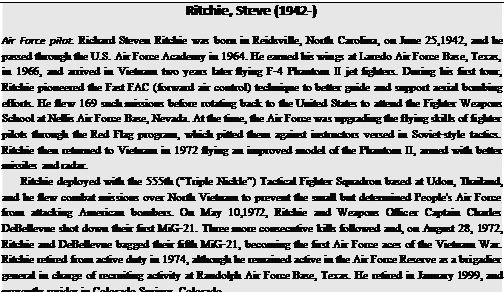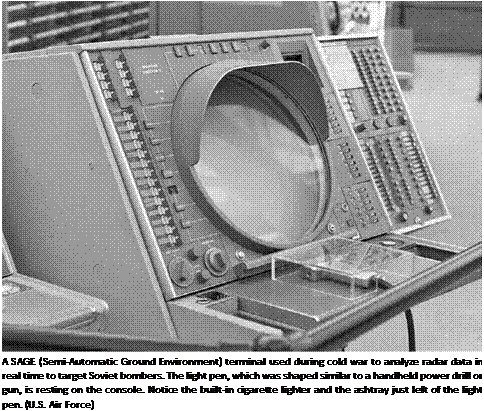. 1987
JANUARY 16 Over the Tonopah Test Range, Nevada, a short-range attack missile (SRAM) is fired for the first time by a B-1B Lancer.
FEBRUARY 3 At Eglin Air Force Base, Florida, the first Sikorsky UH-60A Black Hawk helicopters are delivered to the 55th Aerospace Rescue and Recovery Squadron. The Pace Low III infrared system is retrofitted to them to facilitate long-range search and rescue missions.
FEBRUARY 13—15 On Vanuatu, New Hebrides, survivors of Typhoon Uma are assisted by two C-141 Starlifters and two C-130 Hercules, which transport 64 tons of tents and plastic sheeting for them.
FEBRUARY 16 In San Antonio, Texas, the Joint Military Medical Command, staffed by both Army and Air Force personnel, is activated.
April 14 From Dyess Air Force Base, Texas, a B-1B Lancer flies 9,400 miles in 21 hours and 40 minutes, while utilizing five in-flight refuelings. This is the longest flight to date by a bomber of this
type.
May 5 At Little Rock Air Force Base, Arkansas, the Air Force retires the last liquid-fueled Titan II intercontinental ballistic missile (ICBM) from active service. This is the largest ballistic missile fielded by the United States during the Cold War.
May 6 At Sembach Air Base, West Germany, the 43rd Electronics Combat Squadron receives the first EC-130H Compass Call aircraft.
JUNE 1 The Special Operations Command is established by the Air Force.
June 10 At the Paris Air Show, France, the B1-B Lancer makes its first European debut.
July 4-September 17 A Rockwell B-1B Lancer piloted by Lieutenant Robert Chamberlain establishes 12 new world records for speed and payload. Another Lancer flown by Major Brent A. Hedgpeth sets an additional 9 speed records. For their efforts, the B-1B System Program Office, Air Force Systems Command, wins the Mackay Trophy.
July 17 At Hurlburt Field, Florida, the Air Force Logistics Command delivers the first Sikorsky MH-53J Pave Low helicopter, and it begins operational service within a year. This machine is outfitted for poor weather/nighttime operations and is associated with Special Forces.
July 22—December 21 In the Persian Gulf, Operation earnest will unfolds as Air Force E-3A Sentry aircraft begin routine patrols once the Iran-Iraq War begins spilling over into other countries. Moreover, C-5A Galaxy and C-141 Starlifter transports convey mine-sweeping equipment to the region, while Air Force tankers assist Navy aircraft patrolling the gulf waters.
August 31-September 9 C-130 and
C-141 aircraft deliver 2,511 tons of fire retardant across the coastal regions of Oregon and Northern California, to combat a fire consuming 970 square miles.
September 17 A Rockwell B-1B Lancer piloted by Major Brent A. Hedgpeth sets
9 new world records during a five-hour sortie by carrying 66,140 pounds for 3,107 miles and at 655 miles per hour.
SEPTEMBER 24 Over Beijing, China, the Air Force Thunderbirds demonstration squadron entertains a crowd of 20,000 onlookers.
September 28 A severe bird strike brings down the first B-1B during a training mission. The cost to the taxpayers is $100 million.
OCTOBER 1 At Onizuka Air Force Station, California, the Space Command takes command of the Air Force Satellite Control Network, a set of worldwide remote-tracking stations.
At Hickam Air Force Base, Hawaii, and Clark Air Base, Philippines, the Pacific Air Forces retire their T-33 jet trainers after 32 years of distinguished service.
NOVEMBER 19 In California, the North-
rop Corporation contracts with the Air Force to design and construct the next generation of stealth aircraft, the B-2. While invisible to radar, projected costs per bomber are $1 billion, making them the most expensive aircraft ever built.
November 24 An air-launched cruise missile (ALCM) is successfully deployed by a B-1B Lancer for the first time.
December 5 Six C-130 Hercules transports from the 374th Tactical Airlift Squadron arrive in Luzon, Philippines, bringing in 34 tons of supplies, clothing, and rice to assist the victims of Typhoon Nina.













